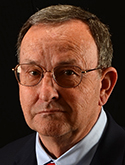News at the HPC²
CAVS Perceives Off-road Unmanned Vehicles as Avenue to Success
December 18, 2018
Glenn Dennis
Director, CAVS-Extension
Director, CAVS-Extension
It’s getting its wish.
CAVS sees itself on a road less taken through its work with the U.S. Army researching and building driverless off-road vehicles. A sign of how far CAVS intends to go is seen behind its Starkville headquarters, where work crews are building a 50-acre track that will provide real-world tests of the modeling and simulations prepared by CAVS’ team of professional and graduate and undergraduates.
Mississippi State created the automotive-research-and-outreach center early in the previous decade with Japanese automaker Nissan’s arrival in Canton. Its work with the auto industry, military, NASA and other institutions and sectors has grown to include innovations in steel, additive manufacturing, hybrid and electrical vehicles, computational fluid dynamics and something CAVS calls “bio-inspired design.” Bio-inspired design seeks to model ways to emulate the marvels of nature (the strength of a woodpecker’s beak, for instance).
In addition to students, CAVS innovators include mechanical engineers, material scientists, metallurgical engineers and physicists. The center landed nearly $20 million in research and development contracts in 2017, up from around $15 million in 2016.
CAVS’ defense-related work with autonomous vehicles moved the R&D center into a niche that is expanding beyond the military to include industrial and commercial users. And the timing couldn’t be better.
Progress in the development of on-road driverless vehicles has convinced executives in manufacturing, construction, mining, agriculture and a host of other sectors that it makes sense to invest in off-road counterparts. Clay Walden, CAVS executive director, says he’s ready to talk to the execs whenever they are.
“We’re interested in anyone interested in off-road autonomy,” says the Starkville-based Walden, a specialist in industrial enhancements.
Walden previously ran the CAVS Extension in Canton. Former associate director and industrial engineer Glenn Dennis now holds that post.
The professionals and students involved in the narrowly targeted technology of driverless off-road vehicles are positioned to make a genuine difference, according to Walden. “It’s a niche where we can contribute and not get lost in the tens of billions of dollars in R&D that we’re not going to touch.”
To that end, CAVS has a technology map for unmanned vehicles that is entirely off-road, he says.
After three years in the autonomous-vehicle space, CAVS decided to grow its stake by building a 50-acre test track and proving grounds behind its Starkville home at 200 Research Boulevard.
“We’re also investing in developing new modeling platforms for autonomous vehicles,” Walden says.
The idea is to test out the modeling on the track and proving grounds. Doing that will be the job of the newly established Mississippi State Autonomous Vehicle Simulation, or MAVS, platform.
Sensors are a particular focus, Walden says.
They come in a range of forms including laser, camera and radar. “You want to be able to model them ahead of testing,” says Glenn Dennis, director of CAVS extension.
This way, Dennis adds, you are testing the parameters established in the models.
As 2018 closes, Dennis and Walden rank creation of “Halo,” as a highlight of the year. The autonomous sport utility vehicle, a Subaru Forrester in its previous life, made its debut recently at the Specialty Equipment Market Association show in Las Vegas.
Built by the MAVS team of students and engineering and technical professionals, Halo is a power-laden all-electric autonomous SUV that CAVS says pushes the boundaries of autonomous vehicle capabilities.
“The vehicle is… paving the way for advancements in a key area with personal, military, agriculture, and search and rescue implications,” CAVS says on its website.
Matthew Doude, CAVS associate director and Halo Project lead, says Halo makes sense if for no other reason than 99 percent of the earth is unpaved. “We needed a vehicle that could be a capable development and test platform both on- and off-road,” Doude said in an October press release that noted Halo has an onboard supercomputer that allows the vehicle to navigate on and off-road terrain without human intervention.
Halo’s get-up-and-go comes from an all-wheel drive with tons of wheel torque from its four independent electric motors, Doude said. “This allows us to do research on topics like self-driving cars, even in rugged environments.”
As a concept car funded in part by private foundations, Halo gave “our engineers and students a way to do some novel things,” Walden says. “It’s basically putting a Mississippi State-style spin on what we see as futurist vehicles.”
CAVS innovations with sensors, guidance systems and artificial intelligence and the like are hardly the extent of its work with autonomous vehicles, especially in its military-related work. In fact, says Dennis, a good amount of effort goes into creating new generations of high-strength steel to reinforce unmanned military vehicles.
Secrecy rules set by the military forbid talking much about that part of the work, according to Dennis.
Meanwhile, says Walden, there’s one thing about going off-road: You make your own roadmap.
Designers of unmanned cars built for the highway have the luxury of paved roads and multi-lane signage and signaling. “Off-road you have a whole set of questions,” he says, starting with how the vehicle reacts with the terrain and how it overcomes obstacles.
In this line of work, Walden says, your innovations best be far out ahead of competitors.
“We’re not going to be successful developing things two or three years out,” he says. “We need to be further out than that.”
By TED CARTER, Mississippi Business Journal
